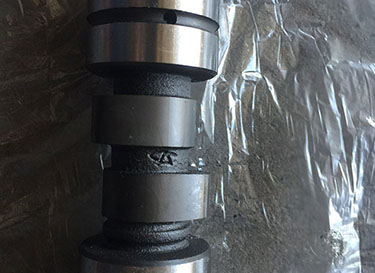Sep. 15, 2020
The camshaft is an important part of the engine's valve train. In order to ensure that the engine can inhale fresh air regularly and discharge the burned exhaust gas in time, the camshaft is responsible for driving the valve to open and close on time. Some camshafts also have the function of driving the distributor to rotate. The speed of the car engine is very high. In order to ensure the efficiency of intake and exhaust, the valve adopts an overhead design. The CHERY camshaft shaft drives the valve action through hydraulic tappets and other mechanisms.
Camshaft structure
Although in a four-stroke engine, the speed of the camshaft is half the speed of the crankshaft, its speed is still very high, and it needs to bear a lot of torque, so the strength and reliable support of the camshaft are very high. The main body of the camshaft is a cylinder with the same length as the cylinder group, with several cams machined on it. The material of the camshaft is generally special cast iron, sometimes made of forged steel and alloy. The interior of most camshafts is made into a hollow structure, which not only reduces the quality of the camshaft but also improves the load capacity of the cam bearing. The camshaft is also processed with a lubricating oil passage through which the lubricating oil passes to provide lubrication for the camshaft, rocker shaft, and rocker arm.

Chery Camshaft
Arrangement of camshaft
Camshafts can be divided into three types: bottom camshaft, middle camshaft, and overhead camshaft according to their placement position. The layout of these three camshafts has its own characteristics.
(1) Lower camshaft and center camshaft. The arrangement of the lower camshaft and the center camshaft is similar. The engine with these two arrangements has better performance at low speed, simple structure, and easy maintenance, so it has been widely used for a long time. At present, few car engines use lower camshafts and mid-mounted camshafts, because in these two arrangements, the distance between the camshaft and the valve is relatively long, and a longer tappet is required to cooperate with auxiliary components such as a rocker arm. To drive the valve, this results in poor smoothness of the engine when working, and noise is easily generated when the valve train is working.
When the engine is working at high speed, the performance of the longer tappet is relatively poor when the camshaft moves, and the tappet is prone to bending and deformation under the action of a large load, and in severe cases, it will cause serious failures such as the valve cannot be opened.
(2) Overhead camshaft (OHC). Most car engines use an overhead camshaft design. This is because arranging the camshaft above the engine can shorten the distance between the camshaft and the valve, eliminating the need for longer valve lifters, simplifying the valve mechanism, and the engine structure can be designed more compactly. The overhead camshaft drives the valve through a rocker arm or hydraulic tappet, thus improving transmission efficiency and reducing working noise. The overhead camshaft also has some disadvantages. This is because although the distance between the overhead camshaft and the valve has been shortened, the distance between the camshaft and the crankshaft has increased, so the transmission metal chain between the camshaft and the crankshaft or The length of the timing toothed tape will increase, resulting in a more complicated design of the transmission mechanism than that of the lower camshaft.
According to the number of camshafts included in the valve train, overhead camshafts can be divided into single overhead camshafts (SOHC) and double overhead camshafts (DOHC).
① Single overhead camshaft. The intake and exhaust valves are driven by an overhead camshaft. Because the intake valve and exhaust valve are located at different positions in the intake port, the accuracy of the valve opening timing will be affected.
②Double overhead camshaft. The double overhead camshaft is developed from the single overhead camshaft. The intake valve and exhaust valve are each driven by an overhead camshaft. Because the intake valve and exhaust valve can be controlled separately, the opening time of the valve can be controlled more accurately. For engines with more than 2 valves per cylinder or V-type cylinder arrangement, the use of dual camshafts can make the valve mechanism relatively simple, and can better control the opening and closing of the valves.
The camshaft overhead makes the distance between the camshaft and the valve smaller, so the rocker arm used for transmission can be made short and light, and the camshaft can even be used to drive the valve directly without the rocker arm. In addition, after the intake camshaft and exhaust camshaft are separated, the freedom of valve arrangement is increased. The spark plug can be easily arranged between the two camshafts, that is, it can be arranged at the center of the combustion chamber. These features makes the double overhead camshaft more suitable for high-speed engines.
We are the OEM NISSAN camshaft factory. If you are interested in our products, please feel free to contact us.
Previous: What Causes a Cracked Cylinder Head?
Navigation
Name: Carrie Zhou
Tel: +023-68886580
WeChat: 0086-13650592877
E-mail: carrie@autopartstf-ws.com
Skype: transfortune
WhatsApp: +86 136 5059 2877
Homepage: www.autopartstf-ws.com